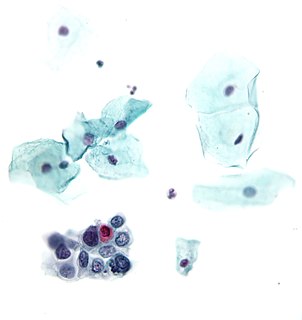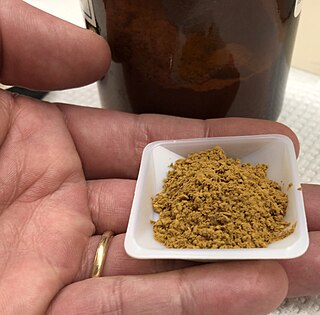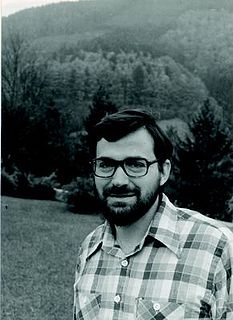
The Papanicolaou test is a method of cervical screening used to detect potentially precancerous and cancerous processes in the cervix. Abnormal findings are often followed up by more sensitive diagnostic procedures and if warranted, interventions that aim to prevent progression to cervical cancer. The test was independently invented in the 1920s by Dr. Georgios Papanikolaou and Dr. Aurel Babeș and named after Papanikolaou. A simplified version of the test was introduced by Anna Marion Hilliard in 1957.

Haematoxylin or hematoxylin, also called natural black 1 or C.I. 75290, is a compound extracted from heartwood of the logwood tree with a chemical formula of C
16H
14O
6. This naturally derived dye has been used as a histologic stain, ink and as a dye in the textile and leather industry. As a dye, haematoxylin has been called Palo de Campeche, logwood extract, bluewood and blackwood. In histology, haematoxylin staining is commonly followed (counterstained), with eosin, when paired, this staining procedure is known as H&E staining, and is one of the most commonly used combinations in histology. In addition to its use in the H&E stain, haematoxylin is also a component of the Papanicolaou stain which is widely used in the study of cytology specimens.

Georgios Nikolaou Papanikolaou was a Greek pioneer in cytopathology and early cancer detection, and inventor of the "Pap smear".
EA is an acronym for Electronic Arts, an American video game company.

Giemsa stain, named after German chemist and bacteriologist Gustav Giemsa, is used in cytogenetics and for the histopathological diagnosis of malaria and other parasites.

Hoechst stains are part of a family of blue fluorescent dyes used to stain DNA. These Bis-benzimides were originally developed by Hoechst AG, which numbered all their compounds so that the dye Hoechst 33342 is the 33,342nd compound made by the company. There are three related Hoechst stains: Hoechst 33258, Hoechst 33342, and Hoechst 34580. The dyes Hoechst 33258 and Hoechst 33342 are the ones most commonly used and they have similar excitation–emission spectra.

Karyolysis, and λύσις lysis from λύειν lyein, "to separate") is the complete dissolution of the chromatin of a dying cell due to the enzymatic degradation by endonucleases. The whole cell will eventually stain uniformly with eosin after karyolysis. It is usually associated with karyorrhexis and occurs mainly as a result of necrosis, while in apoptosis after karyorrhexis the nucleus usually dissolves into apoptotic bodies.

Eosin Y also called C.I. 45380 or C.I. Acid Red 87, is the form of eosin most commonly used in histology, most notably in the H&E stain. Eosin Y is also widely used in the Papanicolaou stain and the Romanowsky type cytologic stains.

Light Green SF, also called C.I. 42095, Light Green SF Yellowish, is a green triarylmethane dye.
Bismarck brown Y also called C.I. 21000 and C.I. Basic Brown 1, is a diazo dye with the idealized formula [(H2N)2C6H3N2]2C6H4. The dye is a mixture of closely related compounds. It was one of the earliest azo dyes, being described in 1863. It is used in histology for staining tissues.

Orange G also called C.I. 16230, Acid Orange 10, or orange gelb is a synthetic azo dye used in histology in many staining formulations. It usually comes as a disodium salt. It has the appearance of orange crystals or powder.

Clue cells are epithelial cells of the vagina that get their distinctive stippled appearance by being covered with bacteria. The etymology behind the term "clue" cell derives from the original research article from Gardner and Dukes describing the characteristic cells. The name was chosen for its brevity in describing the sine qua non of bacterial vaginosis.
Aurel (A.) Babeș was a Romanian scientist and one of the discoverers of the vaginal smear as screening test for cervical cancer. He was the nephew of Victor Babeș, co-author of the first treaty of bacteriology.

Diff-Quik is a commercial Romanowsky stain variant commonly used to rapidly stain and differentiate a variety of pathology specimens. It is most frequently used for blood films and cytopathological smears, including fine needle aspirates. The Diff-Quik procedure is based on a modification of the Wright Giemsa stain pioneered by Harleco in the 1970s, and has advantages over the routine Wright-Giemsa staining technique in that it reduces the 4-minute process into a much shorter operation and allows for selective increased eosinophilic or basophilic staining depending upon the time the smear is left in the staining solutions.
Papanikolaou or Papanicolaou is a Greek patronymic surname, meaning "child of Father Nikolaos", used in Greece and Cyprus.
PRO 140 is a humanized monoclonal antibody targeted against the CCR5 receptor found on T lymphocytes of the human immune system. It is being investigated as a potential therapy in the treatment of HIV infection. The United States Food and Drug Administration has designated PRO 140 for fast-track approval. In February 2008, the drug entered Phase 2 clinical trials and a phase 3 trial was begun in 2015. In February 2018 Cytodyn Inc reported that the primary endpoint has been achieved in the PRO 140 pivotal combination therapy trial in HIV infection.
CytoSport is an American manufacturer of sports-oriented nutritional products, or "supplements" based in Benicia, California. It offers a line of protein-enhanced powders, shakes, and bars has broken into the mainstream market with a ready-to-drink form of protein supplement Muscle Milk, a non-dairy beverage which is trans-fat-free, lactose-free, contain no high fructose corn syrup and is shelf stable. Muscle Milk mainly markets on taste by using familiar milkshake flavors such as banana, milk chocolate and vanilla to drive consumers to the product, along with multiple drink sizes and formats, including powders and being sold in convenience stores alongside regular energy drinks and sports drinks. In Canada, the product is branded as Muscle Mlk, a modification required in Canada to avoid confusion with milk.

George C. Papanicolaou is a Greek-American mathematician who specializes in applied and computational mathematics, partial differential equations, and stochastic processes. He is currently the Robert Grimmett Professor in Mathematics at Stanford University.

Liquid-based cytology is a method of preparing samples for examination in cytopathology. The sample is collected, normally by a small brush, in the same way as for a conventional smear test, but rather than the smear being transferred directly to a microscope slide, the sample is deposited into a small bottle of preservative liquid. At the laboratory the liquid is treated to remove other elements such as mucus before a layer of cells is placed on a slide. The technique allows more accurate results. The UK screening programmes changed their cervical screening method from the Pap test to liquid-based cytology in 2008.















